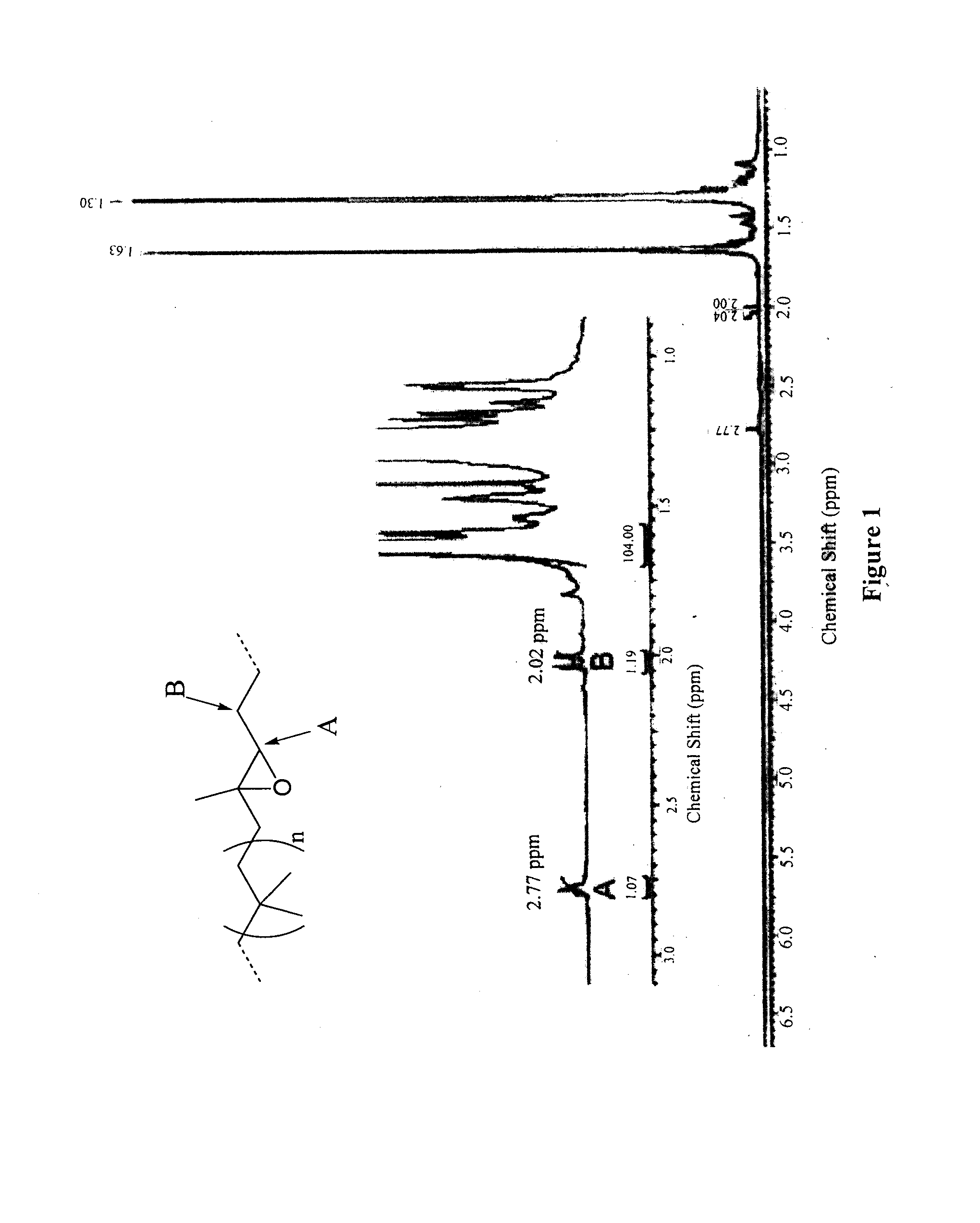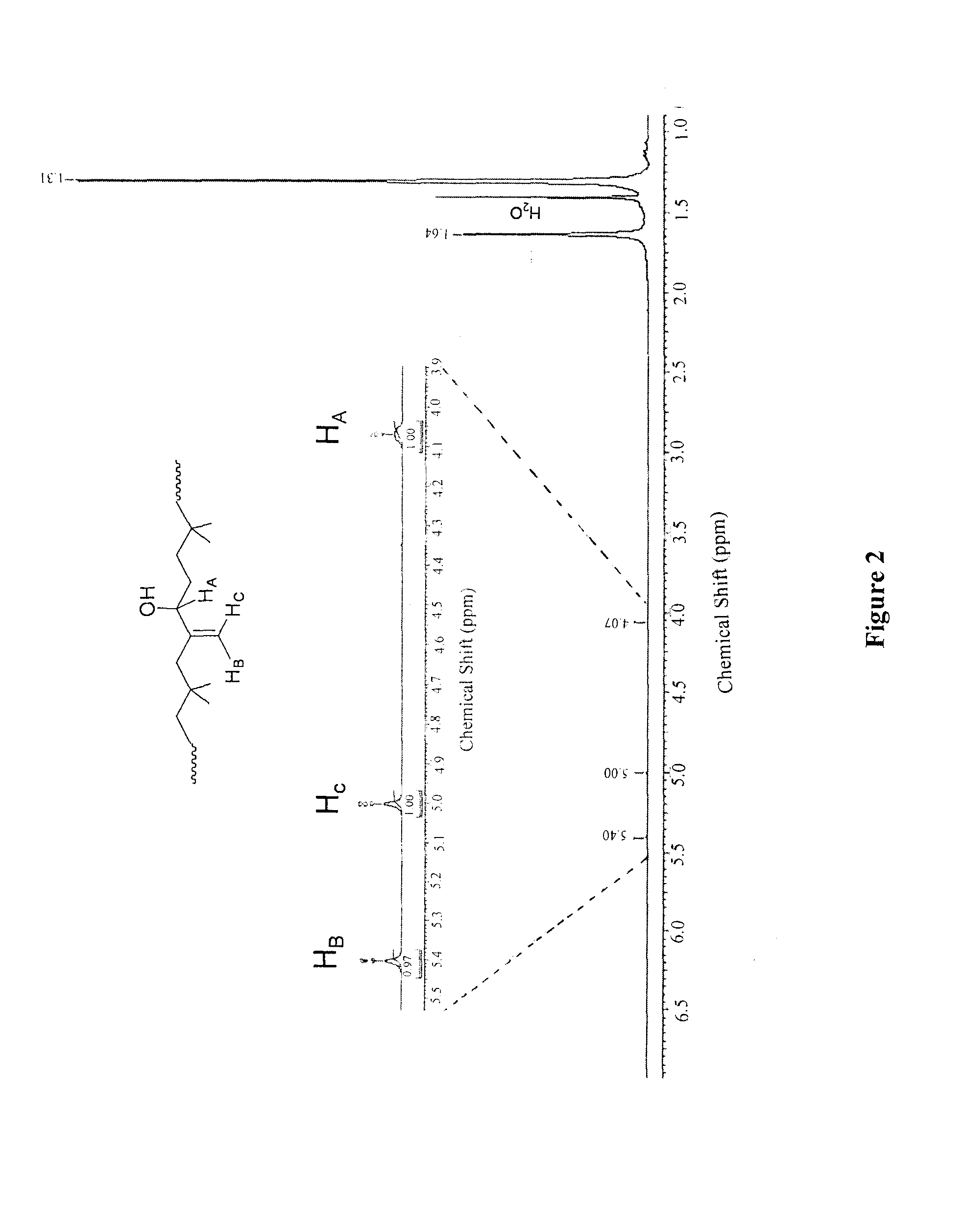Functionalized copolymers of isoolefins and diolefins and their use as compatibilizers
a technology of isoolefins and diolefins, which is applied in the field of polymer functionalization, can solve the problems of additional challenges, inability to remain intact and abrasion-resistant during clinical use in body fluids, metal devices and components, etc., and achieve the effect of improving the wettability of the substrate surfa
- Summary
- Abstract
- Description
- Claims
- Application Information
AI Technical Summary
Benefits of technology
Problems solved by technology
Method used
Image
Examples
example 1
Synthesis of Epoxidized Butyl Rubber (2)
[0097]Butyl rubber (1) (11 g, 4.3 mmol of isoprene units) was dissolved in dry toluene (300 mL). A previously dried solution of meta-chloroperoxybenzoic acid (6.0 g in 180 mL of toluene) was added to the poly(isobutylene-co-isoprene) in solution. The resulting mixture was stirred overnight at room temperature. After evaporation of the solvent in vacuo, epoxidized butyl rubber was purified by precipitation in acetone / toluene (2:1) twice. The resulting polymer (2) was dried under vacuum (yield 91%). 1H NMR (400 MHz, benzene D6): δ 2.77 (t, 1H, J=5.8 Hz), 1.63 (s, CH2 polyisobutylene, 88H), δ 1.30 ppm (s, CH3 polyisobutylene, 264H). SEC: Mw=433000 g / mol, PDI=2.17.
example 2
Synthesis of Hydroxylated Butyl Rubber (3)
[0098]Butyl rubber (2) (10 g, 3.9 mmol of epoxidized units) was dissolved in toluene (300 mL). An aqueous HCl solution (37%, 530 μL 6.4 mmol) was added and the reaction was stirred overnight at room temperature. After evaporation of the solvent in vacuo, hydroxylated butyl rubber (3) was purified by precipitation in acetone / toluene (2:1) twice. The resulting polymer was dried under vacuum (yield 90%). 1H NMR (400 MHz, benzene Do): δ 5.40 (s, 1H), 5.00 (s, 1H), 4.05-4.09 (m, 1H), 1.63 (s, CH2polyisobutylene, 88H), 1.30 (s, CH3polyisobutylene, 264H). SEC: Mw=391200 g / mol, PDI=2.16.
example 3
Synthesis of Acid Functionalized Butyl Rubber (4)
[0099]Butyl rubber (3) (10 g, 3.9 mmol of hydroxylated units) was dissolved in toluene (300 mL). A solution of diglycolic anhydride was prepared by dissolving 10 equivalents of the anhydride (4.5 g, 39 mmol) in toluene (200 mL). The hydroxylated butyl rubber was heated to 75° C. To the solution, 2 equivalents of 4-dimethylaminopyridine (0.95 g, 7.8 mmol) were added, followed by 20 equiv. of triethylamine (10.9 mL). The anhydride solution was added via syringe and the reaction was stirred overnight at 95° C. The reaction mixture was washed twice with 6 M HCl, then the solvent was evaporated. The product was purified by precipitation in acetone / toluene (2:1) twice, then was dried under vacuum (yield 90%). 1H NMR (400 MHz, CDCl3): δ 5.29 (br s, 1H), 5.12 (s, 1H), 4.95 (s, 1H), 4.20-4.40 (m, 4H), 1.42 (s, CH2 polyisobutylene, 174H), 1.12 (s, CH3 polyisobutylene, 431H). SEC: M, =309000 g / mol, PDI=2.52.
PUM
| Property | Measurement | Unit |
|---|---|---|
| mol % | aaaaa | aaaaa |
| mol % | aaaaa | aaaaa |
| mol % | aaaaa | aaaaa |
Abstract
Description
Claims
Application Information
 Login to View More
Login to View More - R&D
- Intellectual Property
- Life Sciences
- Materials
- Tech Scout
- Unparalleled Data Quality
- Higher Quality Content
- 60% Fewer Hallucinations
Browse by: Latest US Patents, China's latest patents, Technical Efficacy Thesaurus, Application Domain, Technology Topic, Popular Technical Reports.
© 2025 PatSnap. All rights reserved.Legal|Privacy policy|Modern Slavery Act Transparency Statement|Sitemap|About US| Contact US: help@patsnap.com



